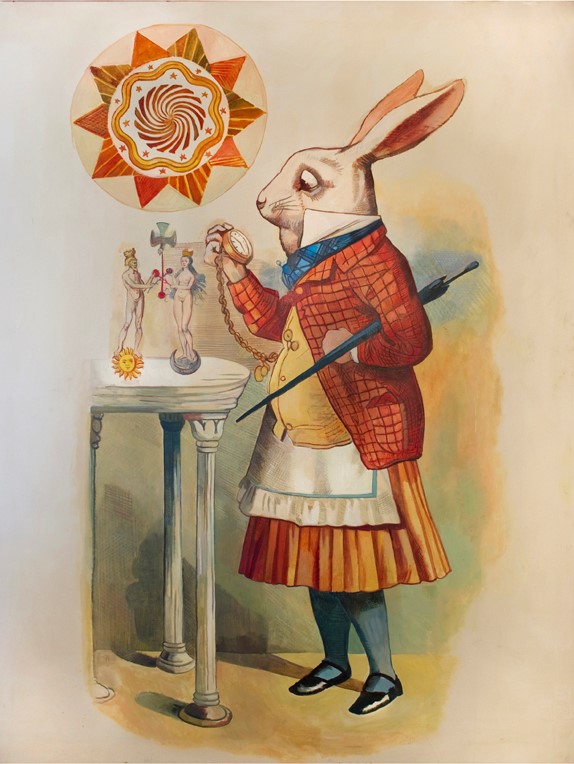Wolfe von Lenkiewicz is an artist who employs some of the most well-known imagery in the history of art to create startling new forms that appear strangely familiar to the viewer – “re-sequencing” iconic works into contemporary pieces with a
Wolfe von Lenkiewicz is an artist who employs some of the most well-known imagery in the history of art to create startling new forms that appear strangely familiar to the viewer – “re-sequencing” iconic works into contemporary pieces with a technique that intentionally mirrors that of genetic manipulation. For his forthcoming exhibition I Have An Excellent Idea Let’s Change The Subject he has re-sequenced John Tenniel’s classic illustrations from Alice In Wonderland, creating a heroine who references everything from the mysteries of alchemy to the cubist abstraction of Picasso. Here, the artist talks to AnOther specifically about the painting Elective Affinities and explains why Alice’s shifting identity maintains her position as one of the most enduringly fascinating characters in the canon of literature, one who consistently challenges the way in which we understand and utiliize the tools of language.
“In 19th century chemistry, the term ‘elective affinities’ was used to describe chemical compounds that only interacted with each other under determined circumstances. The writer Goethe employed this as a universal organising agent running across human relationships and science. I was drawn to these ideas – which are now seen as degenerated methods in modern science – as relevant to language, and how we use it. In this painting, there is an elective affinity between Alice and the rabbit where it ought not to be. They have combined as compounds in an environment (the adventure) that itself has an irrational basis. Alice is effectively married into the rabbit in much the same experimental way Goethe subjects Ottolie to Eduard in his novel. It’s also very interesting to me that Carroll’s rabbit always seems to be subservient to time, retrieving a watch from its waistcoat in a world where time seems to be relative – The Mad Hatter’s tea party, for instance, is outside of time or set in extenuated time, as opposed to the rabbit’s very strict schedule. Inevitably, in the animal’s subjection to human time, a consciousness of death and time running out is reattributed to the rabbit. I am interested in the association of humanist segregation from animalism being broken down here, where the two are communicating and experiencing the same existence in a commensurable way. There is a profound question regarding primitive societies’ relation to animals at play in the normal association of the animal being unconscious of its selfhood – somewhere in between Heidegger’s non-experiencing stone and humanities’ privileged position of holding the logos of language. Carroll breaks this down in the adventures, redistributing awareness – albeit of a human form – to the rabbit. In the painting, the “nearness” of the rabbit to Alice has been eradicated, making them one and the same, when, within the actual adventure, they are separated by haste. The marriage is reflected by an alchemical image – a symbolic picture from an alchemical text showing a crowned man standing on the sun and a crowned woman standing on the moon joining flowers with a descending dove, which represents marriage and the union of two substances. Above these two is a picture of Philadelphia daguerreotypist Frederick Langenheim, who experimented with The Magic Lantern. This image has floated into the painting, as it were, from a chapter of Proust’s Swans Way. The book describes a boy in his bedroom looking at a magic lantern projected onto his wall. He feels both inspired by this medieval “cinema” but also uncomfortable about being transported from his accustomed environment. The painting is a resequencing – if you like – of all these elements and ideas that creates something new. There is a very interesting quote in Alice In Wonderland – “I can't explain myself because I'm not myself you see?” The opposite of which would be something like “I can explain myself because I am.” In proposing this statement, Alice represents what Wittgenstein would call taking “language on holiday”, giving birth to an ill-directed philosophy by asking questions outside of normal language, which always presents us with serious category mistakes regarding essentialist standpoints whenever we try to use its teleology to prove the notion of having a ‘centre’. However, it is a statement that would make absolutely perfect sense if she were part-rabbit.”
I Have An Excellent Idea… Let’s Change The Subject is at All Visual Arts from 12 May until 14 July.
